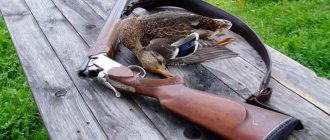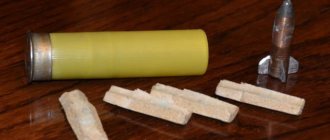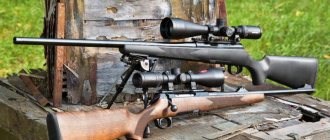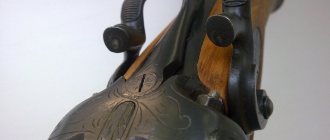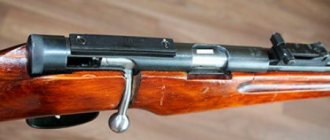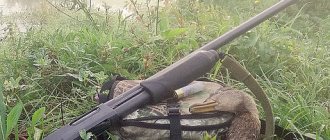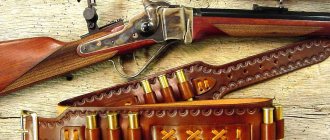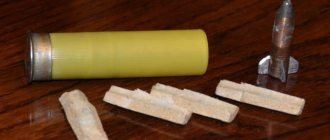Decoration of an antique gun
Austrian fittings
Engraving
IZH - 27 elite
Such guns are produced mainly in the most common calibers: 16 and 12, which allows them to be used for all types of hunting, both for birds and animals, including large ones. When hunting for upland birds or small animals, in areas where wolves, bears, wolverines, lynx and other predators live, the second barrel can be loaded with buckshot or a bullet. This makes it possible to protect yourself at any unexpected moment. This feature of a double-barreled shotgun distinguishes it favorably from even the best multi-shot weapons.
Story
The need for a double-barreled gun appeared immediately with the advent of hunting weapons. This was especially true when guns were loaded from the muzzle side, and the gun’s rate of fire was determined only by the shooter’s skill. Therefore, the double-barreled shotgun we are used to has a rich history of its creation.
There have been many attempts to make a gun with two barrels, so that it would be reliable, light, and with a good action. So already in the second half of the 16th century. In Germany they tried to make a double-barreled shotgun with vertical barrels. But they turned out to be bulky and, most importantly, heavy. In the 7th century, “vender” guns, or, as they were called in Russia, “inverted” guns, were invented in France. These were shotguns with a single lock and a double-barreled rotary block. The shot was fired from the upper barrel, after which the barrel block was rotated 180 degrees, the second barrel was aligned with the lock and the second shot could be fired. The design is complex and the gun is generally heavy.
A more successful design turned out to be a double-barreled gun with horizontal barrels and two flintlocks, one for each barrel. Such a gun was produced by many gunsmiths for quite a long time, and some of the most valuable examples have survived to this day. A significant disadvantage of such guns was that preparation for shooting took quite a lot of time. In addition, flintlocks were very unreliable and often misfired, especially in windy weather, and in the rain they could not be used at all.
Guns with wheel locks, which were invented in the 16th century, became somewhat better in this regard. It was a lock with a spring and a rotating wheel that produced sparks. The lock was wound up like a clock with a separate key. Two locks were installed, separately on each barrel. The trunks were made in two tiers and locks were placed next to them. Some gunsmiths positioned the barrels horizontally, in which case the locks were attached to the left and right. This provided a higher rate of fire. But the design of such locks was far from perfect, oversized and often failed.
An example of such a weapon can be considered a double-barreled hunting musket, which has been preserved in the Augsburg Museum in Germany. The musket was made by master Nikolaus Karpf around 1620. This is a real work of art. As historians have found out, in childhood it was owned by the Saxon Elector Johann Georg II. The musket is made of steel, the stock is made of ebony, inlaid with ivory, artistic carving, engraving and gilding are used.
In Russia, weapons production also did not stand still. Already in the middle of the 17th century, Russian gunsmiths were making double-barreled guns that could compete with foreign ones. A double-barreled arcal with vertical barrels, made in 1654, has been preserved. gunsmiths I. Boltyrev and E. Kuzovlev for Tsar Alexei Mikhailovich.
Shotguns, including double-barreled ones, changed radically after the invention of the cartridge, which combined a powder charge and a lethal element, a bullet or shot, which greatly speeded up the operation of loading a gun. In different countries and by different gunsmiths, different systems for loading guns with ready-to-use cartridges were invented. Eventually, guns that broke off at the bolt, with external or internal hammers, became common. The most successful was the design of a double-barreled shotgun proposed by the Frenchman Leclerc in 1738. Quite quickly, his scheme began to be used by all leading gunsmiths. This type of double-barreled hunting rifle, with some changes, has survived to this day. Here is an example of a classic double-barreled shotgun.
For eminent hunters, guns were made in a set that included the gun itself, replacement barrels and accessories necessary for servicing the gun. All this was placed in special cases that provided reliable and convenient storage of such weapons. Naturally, the cost of such guns was simply enormous. Even now, guns of this design are purely collectible and cost tens of thousands of dollars.
The second version of the double-barreled shotgun was a gun with vertically positioned barrels, the so-called sideflint. Many countries attribute the history of its invention to themselves, although this is not known for certain. Some historians claim that the first vertical gun was made in 1870 by the English gunsmith Giner, and the first vertical hammerless gun was made by the American Parker. Be that as it may, the vertical gun firmly came into use only from the middle of the 20th century, and their mass production was established in many countries, including Europe: Belgium, France, Germany.
What is the external difference between a classic horizontal shotgun and a sideflint - a smoothbore shotgun with vertical barrels.
In Russia, double-barreled shotguns with vertical barrels began to be produced in the 50s at the Tula and Izhevsk factories. In principle, these are the two main Russian arms factories producing hunting weapons. At first these were small-scale guns, intended mainly for clay pigeon shooting. And only in the mid-80s their mass production began.
There are countless brands and models of double-barreled shotguns produced around the world. The most common in Russia are:
The best gun for hunting. The best double-barreled shotguns! Top 5 hunting double-barreled shotguns
A gun room is the longed-for dream of any hunter, and filling it is as exciting as hunting itself. And each piece of the collection is undoubtedly more valuable than any of the trophies. The article is devoted to the high-quality and rational content of the collection. Let's talk about the best hunting rifles.
The classic version of minimal filling is subject to the basic principle of formation: the smaller the number of rifle copies, the higher the quality of each of them should be.
Contents of the gun room
- Smoothbore shotgun with barrel breaker
It is necessary for hunting any type of game, but if you have rifled weapons in your collection, it is mainly used for hunting birds. It is a double-barreled shotgun with horizontal or vertical barrels.
Single-barreled shotgun with manual reloading from a magazine located under the barrel.
Used for hunting predators, large and medium-sized ungulates, and wild boar. The advantage over a shotgun loaded with a bullet is its firing range and accuracy.
It is distinguished by greater compactness and a steeper barrel rifling, which gives the bullet a higher rotation speed around its axis, resulting in high accuracy and longer range.
A gun for practicing the skills necessary for successful hunting: shoulder-to-shoulder, target tracking, smooth descent.
Horizontal or vertical sight: what to choose
Comparative characteristics of shotguns with vertical and horizontal barrels should begin with shooting accuracy. The factor that has the main influence on accuracy is recoil. For a gun with horizontally positioned barrels, the recoil creates a displacement in two directions, in the direction opposite to the barrel from which the shot was fired, and in the vertical plane, the weapon is thrown up. A shotgun with a vertical barrel arrangement is devoid of horizontal displacement and, accordingly, requires less time and effort to return the barrel to the aiming line, this is its undeniable advantage.
Hunting with double-barreled guns often requires a second shot, after a miss, or in order to finish off the prey, the fate of the hunt often depends on its accuracy, many for this reason alone make their choice in favor of vertically positioned barrels. This is a comparison for shooting with shot and buckshot; when using bullet charges, the accuracy of the vertical is even higher, and at its distances, up to 100 meters, in skillful hands, it can match the accuracy of rifled weapons. Minor disadvantages of vertical double-barreled guns include high windage, which in the presence of strong winds makes it difficult to aim and track a target.
Advantages of horizontal shotguns:
- A simpler design for connecting the barrels - butt - stock simplifies the disassembly and assembly of the gun;
- The horizontal position makes it more convenient to grip when throwing up and tracking the target;
- The absence of windage under any wind loads eliminates errors when aiming;
- A target placed in the inter-barrel cavity gives the hunter greater confidence when tracking, which has a positive effect on shooting accuracy;
Disadvantages of horizontal:
- greater displacement of the barrel when fired.
The choice also depends on the chosen method of hunting. If fishing is carried out from huts with decoy ducks or loopholes in storage sheds, where aiming with a stop is possible, the convenience of the horizontal line is undeniable.
Everyone decides for themselves which gun to choose, but common selection practice shows that in a decent gun room there are both options. Beginning hunters first acquire a shotgun with horizontal barrels, and then supplement the collection with a shotgun with a vertical barrel arrangement.
When choosing a shotgun, you should take into account the distinctive characteristics of this type of weapon:
- Choke, choke - this is the size of the muzzle constriction, which affects the accuracy of the battle. The larger the muzzle constriction, the higher the accuracy of the combat; the smaller, the larger the affected area;
- Caliber 12; 16; 20 is the diameter of the barrel, measured not in millimeters, but in the number of bullets of equal circumference that can be cast from one pound of lead. 12 gauge is the most common and popular. In general, the difference between these characteristics lies in the amount of gunpowder and shot placed in one cartridge case. The larger the caliber, the higher the indicator.
When compiling the rating, the following factors were taken into account: choosing a gun is a matter of prestige, budget and personal taste. The presence of domestic weapons is justified; since Soviet times, the country has maintained an excellent rifle industry, one of the few capable of competing in the foreign market. But when choosing budget options, it is necessary to take into account that civilian guns are a by-product of production, and therefore high-quality gun steel can be combined with low-quality assembly and fitting of parts. If you have a needle file and a file, this drawback can be easily eliminated.
The best double-barrel side-by-side shotguns
The rating presents models developed and produced back in the USSR, used for decades by hunters, fishermen and amateurs who have gone through fire, water and copper pipes. Their half-forgotten popularity is caused by smooth-bore machine guns with large-capacity magazines that have come into fashion, but this in no way detracts from their advantages.
Trigger double-barreled shotguns
The Tulka or Tula trigger TOZ-BM has been the most popular gun in Russia for many years. Unpretentious, comfortable, very durable, with a good fight. It served flawlessly in all weather conditions: in frost and heat, in blizzards and rain. It was used for both amateur and commercial hunting of all types of game. From Tulka they killed elk and wild boar, wolf and bear, fox and squirrel, duck, goose and partridge. Since 1964, Tulka was produced under the TOZ-63 brand. It differs from the TOZ-BM with chrome-plated barrels and better finishing.
Tulka 12 gauge from 1968 to 1974. was produced under the symbol TOZ-66. It had a reinforced receiver and chrome-plated barrels. TOZ-66 is considered the best of the Tula triggers. In 1978, the production of triggers was stopped, but in 1986 they resumed, only under the symbol TOZ-80. They were produced until 1990. The technical characteristics and shape of the gun are similar to TOZ-BM and TOZ-66. The Izhevsk plant produced its own version of hammer-fired double-barreled guns. These are IZH43K and IZH43KN. The only difference is that one has internal hammers and external cockers in the form of hammers, while the other has weapons with external hammers. Now trigger guns are no longer produced.
A shotgun is, by the way, serious...
Since those time immemorial, when rifled weapons were created, almost completely replacing smooth-bore weapons, the latter left the battlefield and subsequently developed mainly as a hunting weapon. Nowadays, most people associate the word “shotgun” with an absolutely peaceful picture - a hunter, a dog, a forest, a game... However, this is a very superficial idea of the capabilities of this weapon.
FROM “Trench Rifles” – TO THE PRESENT TIME
Most modern smoothbore shotguns now fit the definition of a shotgun, since they mainly use shotgun and buckshot cartridges. At the same time, rifled weapons, with all their undeniable advantages, are not intended to fire such cartridges - the centrifugal force scatters such a charge too strongly and unevenly, and, in addition, the mass of the shot is extremely insignificant. Thus, thanks to their versatility, shotguns have not yet been replaced from the arsenals of not only hunters, but also the police and the military. In addition, in certain conditions, a shotgun is indispensable as a weapon of self-defense, which, in fact, is what this material will be devoted to. But first, let's talk about his combat advantages, which are by no means a thing of the past.
Retrospective
Without delving into the origins of the development of smooth-bore weapons, we will touch on their participation in world wars and local conflicts. In the last quarter of the 19th century, single-barreled multi-shot shotguns with a smooth barrel appeared and went into production, for example, Winchester, model 1887, as well as the Winchester M97, which was subsequently adopted by the Americans. The latter is the most interesting, because it was he who, after a long historical break, was adopted by the army. The Winchester M97, as well as its further development, the Winchester M12, took part in the First World War. They were used by American soldiers when storming enemy trenches. These shotguns even received a special designation - Trench Gun - “trench gun”. They were single-barreled shotguns with an under-barrel tubular magazine for 5 rounds of 12 gauge (about 18.5 mm). They were reloaded by moving the movable forend back and forth, had a high practical rate of fire, and were equipped with buckshot. These were no longer hunting rifles, even by external signs - a barrel casing that improved its cooling, a bayonet mount. Having small dimensions and weight and great firepower (5 12-gauge cartridges in the magazine + 1 in the barrel), this weapon was much more effective than conventional army rifles in close combat - at distances of up to 30-50 meters. In addition, there are known cases where enemy carrier pigeons were shot down with shotguns.
During the Second World War, shotguns were used significantly less in the army, due to the fact that a new type of weapon became widespread - submachine guns - fully automatic weapons using pistol cartridges.
But the 20th century was rich in wars in completely different climatic zones. The American army once again remembered shotguns during the Vietnam War. In the jungle, where visibility is severely limited by dense vegetation, shotguns loaded with buckshot are once again in demand. Along with the honored veterans of the First World War (Winchester M97 and Winchester M12), the Americans used the Remington-870, a four-shot shotgun with an under-barrel magazine. Its reloading was also carried out by moving the forend back and forth. The Remington-870, in addition to conventional cartridges with a case length of 70 mm, could use magnum cartridges with a case length of 76 mm (they accommodate a larger number of pellets or buckshot).
Shotgun MP-133
Today, shotguns are used by military and police units around the world. They can be seen even in footage coming from Iraq. Some models are created according to the special requirements of these structures. Modern combat shotguns often have 2 weapon operating modes - self-loading and manual reloading, for example, Italian SPAS-12, SPAS-15, Benelli M3 Super 90. Others are even capable of fully automatic fire. In addition, special ammunition is created for modern shotguns that can, for example, disable a car engine, knock out the lock of the front door of a house, etc.
Many examples of such weapons used by army and police units are also available to the civilian population. However, most modern multi-shot shotguns can perform the function of a self-defense weapon. In my opinion, the most preferable in this regard are the so-called pump-action shotguns (Winchester M97, Winchester M12, Remington-870 and the like). Why? Firstly, they are very reliable, and secondly, they can use various types of ammunition, for example, traumatic, the use of which in self-loading weapons is not very effective - the recoil energy of such cartridges is most likely not enough for automatic operation. Thirdly, they are easier to maintain. Fourthly, they can use cartridges with various gunpowders, including smoke.
IT'S HARD TO LIVE IN RUSSIA WITHOUT A SHOTGUN
Manufacturers of domestic weapons, starting around the mid-90s of the last century, have been producing pump-action shotguns. The first was Izh-81. At the same time, the most successful, oddly enough, are the samples from the first years of production of this model - the quality of the barrel is better than that of guns of a later release.
Izh-81
An interesting shotgun is the Bekas, which was originally produced in 16 gauge, and now in 12 gauge. It features a spacious 7-round magazine and good quality barrel. A special feature of this model is that it can be supplied in various configurations, including with two barrels, which is very useful, because it allows you to use the same shotgun for different purposes.
The Bekas family
The Izh-81, which had already been discontinued, was replaced by the MP-133, on which, using a special extension, you can increase the magazine capacity from 4 to 6 rounds.
You can also mention the “Lynx” shotgun produced by our gunsmiths - quite interesting, but not widely used. In it, the magazine was located not under, but above the barrel, which was rigidly connected to the forend and moved back and forth during reloading.
What are the advantages of shotguns under modern Russian legislation? Firstly, they are much more affordable. After all, in order to be able to buy a rifled carbine, you must, as a hunter, own a smooth-bore weapon for 5 years! Secondly, Russian legislation allows you to independently load cartridges for smooth-bore weapons (and prohibits doing the same with cartridges for rifled weapons). Thirdly, a shotgun is an ideal choice for a weapon that you take with you on various hikes through forests and mountains, as it can be used not only as a weapon of protection against wild animals (and not only from them), but also as a means of obtaining food in emergency cases. It is easier to catch a bird or small animal in the forest with a smooth barrel and a shotgun cartridge. Fourthly, shotguns are very effective in terms of self-defense and home defense.
Why is a shotgun preferred for self-defense? Because the concept of self-defense implies contact with an offender at short distances, because a shootout with the same criminal at a distance of 50–100 meters (where a rifled weapon will undoubtedly be more effective) is unlikely to pass for self-defense. And at short distances - up to 30 meters - a shotgun, in my opinion, will be more effective than a rifled carbine, even a self-loading one (it is worth noting that 30 meters is the distance that we can talk about in terms of protecting your home from criminal attacks, because for self-defense it's still a bit much).
It should also be noted that a shotgun is the optimal choice as a self-defense weapon at home, in the country, in the forest, but of course not on city streets. A citizen who has received the right to store and transport civilian weapons, which include shotguns and hunting rifles, can only carry them when sheathed and unloaded - and nothing else.
EVERYONE CHOOSE FOR THEIR OWN
Let's return to the situation of self-defense in your apartment, at the dacha, in a private house or in the forest. The distance, as already mentioned, is unlikely to exceed 30 meters. What type of shotgun to choose for effective self-defense - pump-action or self-loading - is best determined individually. The fact is that not everyone is able to work the moving forend of a pump-action shotgun correctly, for example, in a stressful situation. Thus, women are more often recommended to use self-loading shotguns - in them, to fire the next shot, you only need to press the trigger again. Although, at the same time, it is faster to throw out a misfired cartridge from a pump-action shotgun. However, it is unlikely that the problem with cartridges should be considered as the main one. After all, for self-defense (and this is not such a common thing), you should buy only high-quality cartridges, when used, the probability of misfire is extremely low. You can train with inexpensive cartridges or even self-loaded ones.
"Snipe"
It should be taken into account that when using traumatic ammunition (containing a rubber bullet or buckshot and a relatively small charge of gunpowder), the automatics of a self-loading shotgun will not work. To avoid such situations, you can use shotguns with the possibility of both manual (pump-action) and automatic reloading. Such samples are very expensive, since they are all foreign-made (the MP-154 has not yet become widespread and it is not clear whether it will be), moreover, these are mainly Italian weapons, which, being elegant and of high quality, are expensive.
In fact, with monthly training, if possible, bringing the skill of reloading a pump-action gun to automaticity is not a problem. In my opinion, training is also necessary in order to get used to the recoil and sound of the shot.
If we talk about choosing a caliber, it is selected empirically individually for each person. I've seen fragile women handle a 12-gauge shotgun just fine. Some healthy and large men prefer the same 20 gauge (about 15.5 mm). The fact is that when the caliber decreases, not only the recoil weakens, but also the roar of the shot. It is also necessary to take into account that in a closed space the sound of a shot will be perceived as much louder compared to a shot on the street.
ABOUT AMMUNITION FOR SELF-DEFENSE
Here we can say the following.
If you are going to the forest, where you can meet not only citizens who “sometimes don’t want to live honestly here and there,” but also wild animals such as a wolf or a wild boar, then it is better to load cartridges with buckshot or combined cartridges (bullet + buckshot) into the magazine ). In addition, there are special cartridge belts on sale that can be attached directly to the weapon - on the receiver or on the butt. Re-equipping weapons is perhaps the most efficient of them. Therefore, you can put several cartridges filled with a bullet and large buckshot into such cartridge belts, just in case. English pump action shotgun Mk5
At the same time, you need to remember that your main weapon is your head. You should not fire at any passing shadow or swaying branch, even if you are in a deep forest. Weapons are the last resort when the others are no longer useful. If it is possible to avoid a close encounter with an animal, even if you are confident in your shooting training and your weapon, do not risk it. However, the same applies to armed and/or outnumbered criminals. It would be wiser to report them to law enforcement rather than start a shootout with them. Naturally, if you have such a choice.
If you plan to use a shotgun within your house, apartment, or cottage, then you can limit yourself to large shot or small buckshot of 4.5–6.2 mm caliber. Firstly, at distances of up to 25–30 meters, a sheaf of this shot will quite effectively incapacitate a criminal (in most cases, hitting 1/3 of the total number of pellets in the cartridge is sufficient). However, the chance of causing a fatal wound is still reduced compared to large buckshot or a bullet. Secondly, the likelihood of a through wound is sharply reduced, and therefore the likelihood of causing harm to third parties. In addition, given the density of modern cities, the likelihood of harm to third parties is reduced in the event of a miss on a criminal who, for example, is in the background of a window - the smaller the buckshot or shot, the faster it loses its energy.
If the expected contact distance is limited to 5–7 meters, you can also use ammunition for smoothbore shotguns with a rubber bullet and buckshot. At short distances, these ammunition are very effective, and the likelihood of causing a fatal wound, although present, is still significantly less than when using lead shot or buckshot. And psychologically, using such ammunition against a person is much easier for many. In addition, since the powder charge in these cartridges is less than in conventional cartridges, the recoil of such cartridges is noticeably less. The same applies to the sound of a shot. True, when using such cartridges, say, in an apartment, you need to be prepared for the fact that a rubber bullet or buckshot can give an unpleasant ricochet.
Winchester Super X2
Thus, we can conclude that in modern Russian realities, a shotgun is the optimal choice for a person who wants to get a universal weapon, suitable both for hunting and for protecting his home from criminal attacks, etc. After all, the effectiveness of shotguns as military weapons has been proven by their use by the armies of various countries (primarily the United States) in local conflicts, as well as by the fact that their various models are in service with modern armies (the same US Coast Guard), as well as police units of a fairly large number of countries in the world.
Valery Guryanov “Soldier of Fortune” No. 5-2007
Hammerless double-barreled horizontal shotguns
Trigger guns have a significant drawback. This is one extra operation - cocking the hammers, which means a lot during hunting, especially when shooting at moving targets. Therefore, triggerless horizontal guns have become the most convenient and more common in this regard.
We also produce them at the Izhevsk and Tula factories. The most popular, regardless of the year of manufacture, were the Izhevsk IZH-58 and IZH-43 and their further modifications, produced under various indices: IZHB-36, IZHB-36M, IZHB-46 and IZHB-47, IZH-49, IZH-54, IZH-57, IZH-58 and IZH-58M, IZH-58MA, IZH-58MAE and IZH-58MA-20M, IZH-26 and IZH-26E, IZH-41, IZH-43, IZH-43M, IZH-43EM.
Less common, but preferred by a certain category of hunters, are Tula double-barreled shotguns, often made in small batches or to order. TOZ-25, TOZ-39, as well as MC-10, MC-110, MC-11, MC-111. The most popular, even in our time, is the 12-gauge double-barreled shotgun MTs 111.
It is impossible not to recall foreign-made guns, although not in large quantities, but which were constantly available in the arsenal of our hunters. These were mainly SAUER guns, captured, with Krupp steel barrels, or produced in the GDR. SAUER hunting and sporting weapons, which are manufactured in Suhl in Germany, are now world famous and very popular in Russia.
Vertical arrangement of trunks
Over-shooter 12 gauge... It would not be a mistake to say that it is the most common hunting weapon of our time. Well, maybe only semi-automatic machines compete with it in this. Only the semi-automatic machine was and will always be the weapon of pragmatists (the cult “Browning A5” and “Kozmi” do not count), and the double-barreled vertical shotgun, although it was a “fashionable innovation” at one time, has now deservedly acquired the unique aura of “the weapon of real hunters” " Why did many of the most famous companies, style setters in the world of elite smooth-bore weapons with horizontal barrels, such as Perde and Holland-Holland, at one time begin to develop and produce vertical guns? There are several answers.
First and foremost, guns with vertical barrels by design have a significantly longer service life with less labor required for their production. The connection of the receiver block with the block in verticals has greater rigidity due to the side surfaces of the box and a large area of additional locking elements. In addition, good vertical smoothbore guns have locking elements located between the axes of the barrels. Thus, when firing from the lower barrel, the barrel block is, in principle, not affected by the moment of force that opens the gun, and when firing from the upper barrel, it is minimal. This allows you to achieve a long (and even huge) service life with much less precise and labor-intensive manual adjustment of the locking unit. But survivability is far from the only objective reason for the popularity of verticals.
There are several more very important points for hunting and shooting sports. Well, the first thing - as you know, in hunting, 80 percent, if not more, of shots are fired from one - the first barrel. And this vertical trunk is the bottom one. Compared to the horizontal, it is located lower and its projection comes closer to the heel of the butt (sometimes directly into it). Thus, when firing, due to the smaller moment of force, there is less tossing of the weapon with the barrels moving away from the aiming line. Good shotguns, say, Italian over-and-unders with a properly fitted stock, do not have any barrel bounce at all when fired from the lower barrel - the recoil energy is completely absorbed into the shooter's shoulder and body. This greatly facilitates particularly fast shooting, which is why 99.9% of sporting smoothbore weapons are over-and-under.
In addition, with a vertical barrel arrangement, the shooter’s leading eye essentially sees one (upper) barrel, and this, to a lesser extent than with horizontal barrels, prevents vision from completely focusing on the target when shooting in flight. There are a few more points - a forend that is more convenient for gripping and controlling the gun, eliminating finger contact with the barrels, which are sometimes quite hot, and the ability to use ventilated inter-barrel strips and couplings to connect the barrels. In general, in terms of ergonomics and manufacturability, the over-and-under double-barreled shotgun objectively outperforms the horizontal double-barreled shotgun. But... the popularity of hunting weapons is determined by more than just objective reasons. And thank God.
Let's talk better about such a common topic as choosing a vertical frame. The most popular today is, of course, the 12 gauge over/under, as it is the most versatile and has the largest selection of ammunition. 16 gauge today is an endangered one. Guns in this caliber are practically not produced - except to order. And the 16-gauge over-and-under is sold today mainly in thrift stores. But the 20 gauge feels quite confident. Therefore, 20-gauge over-and-unders are necessarily present in the catalogs of almost all arms companies producing smooth-bore weapons. Due to their low weight (2.5-2.7 kg or less), such guns are primarily suitable for fast and very fast shooting. And the small loads of shot and the 20-gauge’s inclination to spread out fights make it possible not to break the game short. This combination is ideal for shooting from under a dog. But at the same time, 20-gauge magnum cartridges with a shot weight of 32 grams when using solid shot, especially with a buffer (sprinkling with starch or special industrial bulk materials that reduce the deformation of the lower layers of shot during acceleration in the first third of the barrel), allows achieving the characteristics of a 12-gauge shot . And such guns are quite suitable for duck and goose flights, not to mention more “sensitive” game such as pigeons.
But hunting is not just shooting with shotguns. And the double-barreled vertical shotgun is quite successfully used in game hunts. It is worth noting here that installing additional sights on the vertical is easier than on the horizontal. For game hunting, say, a very useful thing is a collimator. He aims at the barrel from which the shooter is going to fire the first shot. Usually this is the lower trunk, why? – described above. With a vertical arrangement of the barrels, it would seem that the gun should “cross” in a vertical plane - i.e. due to the non-parallelism of the axes of the barrel channels, one barrel should hit clearly higher than the other. In fact, the STPs of different trunks usually diverge in the horizon. With good guns, this discrepancy at a distance of 35 meters is usually less than the width of your palm. But for shooting at 50 meters or more, and smooth-bore ammunition such as the Sovestra bullet has a flat trajectory that allows you to shoot at a distance of up to 100 meters without vertical adjustments in the sight, the shooter, of course, better know where the bullet is flying from the second barrel immediately after firing the first one.
In general, good shotguns with vertical barrels, i.e. high-quality made, with good balance and controllability and with a fitted stock, they are absolutely suitable for any type of smooth-bore hunting, and in addition, they allow their owners to regularly improve their shooting skills on a stand without significant damage to the service life of the weapon. Some models are quite universal - with them you can practice clay pigeon shooting very seriously and achieve high results in this sport, and at the same time hunt no less successfully. Of course, carry a gun weighing 3.5 kg or more while hunting. – this is not an acquired taste, but many are willing to sacrifice weight for the sake of results. After all, you are best able to shoot from a gun that you regularly practice with.
Double-barreled over-and-under shotguns
Smoothbore hunting rifles with two vertically positioned barrels are a separate page in the development of hunting rifles in our country. Produced first in small batches as sporting weapons, over-and-unders eventually became the most popular guns for hunting. The Russian industry produces several models of such guns. The most famous and popular are: Izhevsk IZH-27 and more advanced MP-233 calibers - 12, 16, 20, 32 and 410, Tula TOZ-34, TOZ-120 and TOZ-200 chambered for Magnum class cartridges. They are intended for both sporting and amateur and commercial hunting. They have excellent balance, good adaptability and high accuracy of combat.
Of course, many wealthy hunters prefer to purchase German Sauer or Zimson, Austrian Mannlicher, French Verney-Carron, Italian Benelli or Breda, American or Portuguese Browning, Turkish Armed, and other foreign celebrities. But real Russian hunters still rightfully value their domestic guns and we support them in this, and we wish the same for you. I think that when choosing a hunting rifle, you will take into account what you read in this review.
How to choose a double-barreled shotgun
Photo by Anton ZHURAVKOV
The years of the strongest “goose rush” have passed. It's 2016. Gradually it becomes calmer in this sense. Indeed, the strong pressure of the many thousands of St. Petersburg army of hunters on the spring goose migration brought these smart, organized and flexible birds to their senses, and they began to change their flight routes. There were few of them in the spring on the favorite fields of Koporye, Volosovo and Gatchina.
Now we need to prepare for a long-distance expedition to the Novgorod region, Karelia, the Pskov region and other places. This significantly cools the ardor of the so-called goose hunters. Advertisements appeared for the sale of used semi-automatics, bought in the heat of the moment during the goose boom.
Finally, they began to remember that in the spring there is both wonderful (for the soul) hunting with woodcock, and hunting with decoys (or stuffed animals) for drake. And hunting for the grouse current (with surprise to learn that the coldest place in the world is a hut), and hunting for the current of a relict bird - the same age as the mammoth - the capercaillie.
And then it became clear that a semi-automatic weapon was not needed at all for such hunts. It’s easier and more pleasant to take an ordinary 12-gauge double-barreled shotgun. It could be the 16th or even the 20th. With a double-barreled shotgun, if all other conditions are met on the field, you will also not be left without trophies. Observe camouflage, choose a route, arrange profiles and decoys, use decoys correctly, show restraint, shoot moderately... Not to mention that in the forest it is more convenient with a double-barreled shotgun (with two different cartridges in the chambers).
I loaded the “seven” and “one” in September. And a hazel grouse that suddenly appears can be beaten or a wood grouse... And if a meeting with an animal is expected, then there is a bullet in one barrel, a shot in the other. Also, a double-barreled shotgun, compared to a self-loading shotgun, is easier to maintain and safer to use.
You can buy such a gun in a store - new or used. There is no need to be afraid that someone has already gone hunting and shot with him. People have a lot of excellent double-barreled shotguns, both horizontal and vertical. Moreover, most of them have 70 mm chambers (a 12 by 76 chamber is, in principle, for steel shot). For the usual listed spring hunts (and even autumn ones), a 70 mm chamber is preferable.
In addition, they usually have monolithic trunks. That is, there are no screw-in attachments (more on them later). In stores, most likely, they can offer domestic shotguns MP27 (IZH27), MP43 (IZH43), MP18 (IZH18) (single-barrel). And in a thrift store (or on a used guns website) there is a wide variety of them. And Tula double-barreled shotguns TOZ 34, TOZ 91, TOZ 120, TOZ 200 and Izhevsk - IZH 27, IZH 271s, IZH 43, IZH 26, IZH 58, IZH 54, IZH Sputnik, IZH 12 and various imported guns (there is no way to list them , such is their diversity).
This is where the question of choosing and inspecting a gun before purchasing arises. First of all, you need to decide what to take? With vertical trunks or horizontal? I've been getting asked questions like this a lot lately. There is no clear answer here. Much depends on the hunter’s desires, habits, his taste and, above all, his build and shooting style. If possible, you need to hold the gun in your hands, raise it, and determine whether it suits him in terms of anthropometry.
Shotguns with vertical barrels have a better view of targets; the gun has no lateral deflections when firing; when shooting from the lower barrel, there is less upward movement of the barrels. The gun is stronger and less wobbly.
For running hunting, guns weighing from 2.8 to 3.3 kg are most suitable. It is calculated like this. The gun should weigh 1/22 of the hunter's weight. For ambush, you can take a heavier gun, weighing 1/19 of the hunter’s weight. A lightweight gun (for women and teenagers) should be 1/25 of the owner's weight. Shotguns of 12 gauge generally weigh 3.0–3.3 kg, 16 gauge — 2.8–3.0 kg. If hunting involves a long walk, then a heavy gun will be burdensome. In general, a hunter, without any tension or fatigue, should raise his gun twenty times, aiming at the same point, then this is his gun.
The length of the stock should be selected depending on the length of the arm. With an arm length of 42 cm, the length of the stock should be 38-40 cm, with an arm length of 41 cm - 37-39 cm, with 40 - 36-38, with 39 - 36-37, with 38 - 34-36, with 37 - 33 –35, at 36 – 32–34 cm.
The vertical angle (steepness) of the stock depends on the distance between the collarbone and the shooter's eye. It is measured from the extension of the aiming line to the front edge of the ridge of the butt and from the extension of the aiming line to the heel of the butt.
With a distance from the eye to the collarbone of 22 cm, the die at the beginning of the ridge should be 41–43 mm; at the butt plate 65–69 mm; at a distance from the eye to the collarbone of 21 cm, respectively at the beginning of the ridge 40–41 mm, at the butt plate 64–68 mm, at 20 cm at the beginning of the ridge 39–40 mm and at the butt plate 63–65 mm, at 19 cm at the beginning of the ridge 37– 38 mm, at the butt plate 60-62 mm, at 1 cm - at the beginning of the ridge 35-36 mm, at the butt plate 58-59 mm, at 17 cm - at the beginning of the ridge 34-35 mm, at the butt plate 57-58 mm at 16 cm - at the beginning of the ridge 33–34 mm, at the butt plate 56–57 mm.
You can check the compliance of the vertical loss in a practical way. The shooter aims at a point at a distance of 5-6 m at eye level. When he takes aim, place a match on the gun's rib across the barrel, 20 cm from the breech. If the shooter cannot see the front sight through the match, then the bend of the stock is too large for him. If the shooter sees the front sight and part of the bar, then the bend is small. If only the front sight is visible through the match, and the pencil placed instead of the match covers the front sight, then the bend is normal.
The touch of the cheek to the comb should be uniform. The cheekbone protrusion on the butt lifts the shooter's head away from the comb and thereby eliminates a blow to the cheekbone, allows for consistent shooting, and prevents the gun from falling off. The protrusion must exactly match the lower part of the face, otherwise it will only get in the way. For fast shooting, a straight and fuller comb is desirable. If the ridge is too high, the cheek will be pressed tighter, and hence will receive a stronger blow. The gun will rise up.
The shape of the stock can be English (straight), without a protrusion at the bottom of the neck. It is believed that with such a stock, the shooter’s hand moves more easily to fire the second shot (with two triggers). There are stocks with a projection and soft outlines - this is a half-pistol stock. In a stock with a pistol-shaped neck, the protrusion slopes down steeply. I don't recommend taking a stock with a very "cool" gun.
For ease of control of the gun, it is important that it be maneuverable, that is, most of the weight of the gun would be concentrated between the shooter’s left and right hands, and the ends of the gun should be as light as possible. The posadism of a gun is judged by the posadist coefficient (KP). It is defined like this. The weight of the receiver with the butt is divided by the weight of the barrels with the forend. It’s good if the CP is equal to one. Posadism can be judged by other criteria. For removed barrels with a forend, the center of gravity should be at a distance of 11-12 cm from the breech.
The balance of the gun is also important for shooting. For high-end shotguns, the center of gravity is located 45–50 mm from the breech, for ordinary shotguns it is 65–75 mm. If the center of gravity is located 80 mm from the breech, then it will be difficult to shoot from such a gun at moving targets (it may lower it). The balance index (BI) is defined as the ratio of the weight of the gun to the weight of the barrels. For a double-barreled shotgun it is usually 2.0–2.3, for a three-barreled shotgun - 1.8-1.96, for a rifle - 1.75-1.8. The smaller the PB, the more difficult it is to shoot offhand at moving targets.
It is advisable to pay attention to the pitch - the angle between the extension of the aiming bar and the plane of the butt plate. If the butt to the toe is longer than to the heel, then when thrown up, the barrels will be directed higher. And, conversely, the protrusion in the toe of the butt fixes the position of the butt in the shoulder.
The butt plate can be made of plastic, rubber or steel. For successful shooting in winter and autumn/spring, it is advisable to have replaceable butt pads. For winter - thinner butt pads, taking into account warm clothing.
Pitch is expressed in linear measures. If the barrels (along the sighting bar) are located at an angle of 90 degrees to the cut of the butt plate, the pitch is zero; with the ends of the barrels lowered down, the pitch is negative. And when the trunks deviate upward from the vertical, the pitch is positive. The normal value for a universal shotgun with barrels up to 720 mm in length is considered to be a negative pitch of approximately 3 cm.
Anatoly Azarov February 29, 2016 at 00:37

